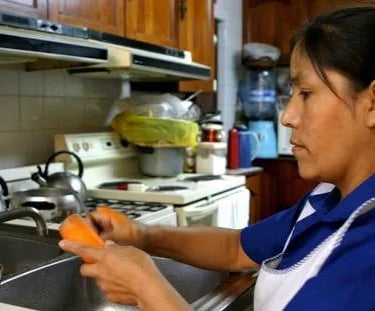Subscribe to our youtube channel today! @medellin_unfiltered
An Expat’s Guide to End-of-Year Liquidación Payments for Domestic Employees in Colombia
As a foreigner living in Colombia, understanding the nuances of hiring domestic employees is essential. One crucial aspect of this relationship is the end-of-year “liquidación” payment, an additional expense you’ll likely need to account for. Here’s a comprehensive guide to navigate this responsibility, draft the necessary documentation, and consider alternative options to simplify the process.
EXPATS
Steve Hamilton
12/14/20244 min read


What Is the End-of-Year “Separación” Payment?
In Colombia, domestic employees, such as housekeepers, nannies, and gardeners, are entitled to a range of labor benefits under the law. Among these benefits is the prima de servicios, a mandatory semi-annual bonus, and a cesantías (severance fund), which accrues throughout the year and is intended to provide financial support in case of job loss.
Many employers also provide a goodwill end-of-year separation payment to acknowledge the additional financial pressures employees face during the holiday season. Though not legally required, this gesture strengthens employer-employee relations and upholds cultural expectations in Colombia.
Preparing for the Payment: Communication Is Key
Open communication with your domestic employees is essential. Discuss their expectations for the end-of-year payment in advance—ideally before December begins. This conversation can:
Clarify expectations: Ensure both parties are aligned on whether a payment will be made and its amount.
Avoid surprises: Nobody enjoys last-minute financial stress.
Strengthen relationships: Respect and transparency go a long way in maintaining trust.
Writing the Separation Payment Letter
If you decide to provide an end-of-year separation payment, formalizing the agreement in writing is highly recommended. A simple letter ensures clarity for both parties and serves as proof of the transaction.
Here’s a step-by-step guide to drafting the letter:
1. Include Key Details:
Employer’s full name and identification (cédula extranjera or passport number).
Employee’s full name and identification (cédula de ciudadanía or equivalent).
Payment amount in both figures and words.
The purpose of the payment (e.g., end-of-year bonus, separation agreement, or goodwill payment).
The payment date.
2. Use Clear Language:
Write in straightforward Spanish or English (if both parties are comfortable with it). Example:
Carta de Pago de Separación de Fin de Año
Medellín, [Date]
Yo, [Your Full Name], identificado/a con [Your ID Type and Number], declaro que hago el siguiente pago a [Employee’s Full Name], identificado/a con [Employee’s ID Type and Number], correspondiente al bono de separación de fin de año.
Monto: [COP Amount in Words] ([COP Amount in Figures]).
Fecha de pago: [Date].
Con esta transacción, ambas partes reconocemos la finalización de las obligaciones laborales correspondientes al año en curso.
Firma del empleador: __________________________
Firma del empleado: __________________________
3. Create Copies:
Prepare two signed copies of the letter—one for the employee and one for your records. This ensures transparency and protects both parties in case of future disputes.
Why Documentation Matters
Keeping thorough documentation is not just a bureaucratic formality; it’s a vital safeguard. Proper records provide:
Proof of compliance: Evidence that you’ve fulfilled your financial obligations.
Conflict resolution: A clear record of what was agreed upon if misunderstandings arise.
Tax support: If audited, these documents can verify payments made to employees.
Alternative Approaches: Service Companies with SAS
If the complexities of hiring and managing domestic employees feel overwhelming, consider engaging a service company registered as a Sociedad por Acciones Simplificada (SAS). These companies employ domestic workers directly and handle all legal and administrative tasks, including:
Payroll and benefits.
Social security contributions (e.g., health, pension, and ARL).
End-of-year and severance payments.
Benefits of Using a SAS Service:
Time savings: You won’t need to manage payroll, taxes, or labor law compliance.
Legal security: The company ensures all legal obligations are met, protecting you from potential liabilities.
Flexibility: SAS companies often provide backup staff if your regular worker is unavailable.
Popular domestic service platforms in Colombia include ServiHogar, Domestik.com, and local agencies within your city. Compare options to find a reliable provider that suits your needs.
Weighing the Costs: Direct Employment vs. SAS Services
Direct Employment:
Pros: More control over hiring, often lower costs.
Cons: Administrative burdens, potential legal liabilities.
SAS Services:
Pros: Hands-off management, reduced legal risks.
Cons: Higher fees, less control over employee selection.
Additional Tips for Employers
Plan Your Budget:
Factor in end-of-year payments as part of your annual household budget to avoid financial strain.Understand the Law:
While separation payments are not mandatory, other benefits like prima and cesantías are legally required. Familiarize yourself with these obligations to avoid unintentional non-compliance.Set Clear Expectations:
Discuss the scope of work, salary, and benefits with your domestic employee at the start of their employment. Transparency minimizes misunderstandings later.Seek Professional Advice:
Consult with a Colombian labor lawyer or accountant to ensure you’re meeting all obligations correctly.
Preparing for End-of-Year Expenses
Colombian culture places significant importance on holiday celebrations. For domestic employees, the end-of-year period often comes with additional expenses for gifts, travel, and family gatherings. Offering a separation payment demonstrates cultural sensitivity and goodwill, strengthening your relationship with your employee.
However, planning is essential. Avoid scrambling at the last minute by:
Calculating the payment early: Determine a reasonable amount based on your employee’s salary and years of service.
Setting aside funds: Save throughout the year to cover this and other holiday expenses.
If you need more information about whether your domestic help qualifies, please read this article for more information https://lawyerscolombia.com/domestic-workers-and-colombian-law/
To figure out the amount owed, the Colombian govt. has a calculator of how to calculate this: https://www.mintrabajo.gov.co/atencion-al-ciudadano/tramites-y-servicios/mi-calculadora WARNING: It's in Spanish, but you can get the gist of it, or translate the page with the Translate extension with Chrome.
EDIT - Adding a spreadsheet for you to determine the right amount to give for your liquidacion: DOWNLOAD
The Long-Term Perspective
Establishing fair and respectful employment practices benefits you as much as your employee. A happy, motivated domestic worker is likely to provide better service, creating a harmonious household environment. By handling end-of-year payments with care and professionalism, you contribute to a positive employer-employee dynamic.
In summary, paying an end-of-year separation to your domestic employees in Colombia requires preparation, clear communication, and documentation. By understanding your obligations and exploring alternative solutions like SAS service companies, you can ensure a smooth and stress-free experience. Prioritize open dialogue with your employee and approach this process as an opportunity to build trust and goodwill. It’s not just a legal or cultural expectation—it’s a reflection of your commitment to fairness and respect.
Medellin Unfiltered
Discover the real Medellin, without filters.
CONTACT US
info@medellinunfiltered.com
© 2024 GWM Ventures. All rights reserved.
LEGAL




